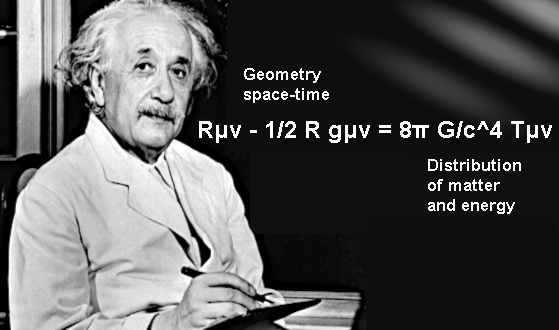
Image: Albert Einstein (1879-1955) is a theoretical physicist, Nobel Prize in Physics (1921) on the corpuscular nature of light, by studying the photoelectric effect.
The equation of general relativity is the fundamental equation of gravity published by Albert Einstein in November 1915. This major achievement by Einstein describes how the presence of matter and energy bends spacetime, and how moving objects move through this curvature.
The general relativity equation is expressed mathematically using tensors and tensor calculus. A tensor can be seen as a generalization of a multi-dimensional vector.
Simplified, the basic equation is known as Einstein's equation and can be written as: Rμν - 1/2 R gμν = 8π G/c^4 Tμν
- Rμν is the space-time curvature tensor, which describes the curvature of space-time as a function of the distribution of matter and energy.
- R is the curvature scalar, a quantity derived from the curvature tensor.
- gμν is the metric tensor, which represents the metric of spacetime and describes how distances and time intervals are distorted by curvature.
- G is the gravitational constant, approximately 6.67430 x 10^-11 m³/(kg s²).
- c is the speed of light in vacuum ≈ 299,792,458 m/s.
- Tμν is the energy-momentum tensor, which represents the distribution of matter and energy in space-time.
This equation relates the geometry of spacetime (left side) to the distribution of matter and energy in the universe (right side). It describes how matter and energy determine the curvature of spacetime, and how this curvature influences the movement of objects and the propagation of light.
The general relativity equation has led to some extraordinary predictions, including the existence of black holes, gravitational waves, and light deflections around massive objects. It has also profoundly altered our understanding of gravity and the large-scale structure of the universe. General relativity is one of the most confirmed and verified theories of modern physics (Precession of Mercury's orbit, Deflection of light by the Sun, Shapiro Effect, Gravitational lenses, Gravitational waves...).